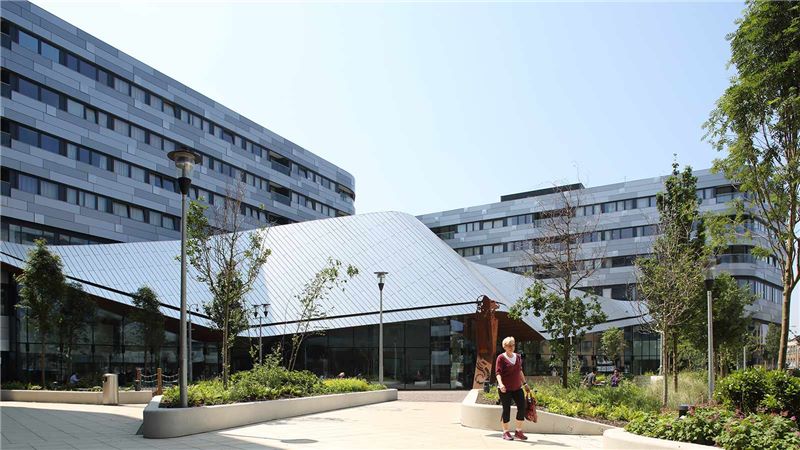Unleashing the potential of our towns and cities
Across the globe, cities and towns have suffered the brunt of the impact of coronavirus. Globally approximately 95 percent of people who have caught COVID-19 live in urban areas. A combination of density, connectivity and deprivation make urban centres the perfect places for the disease to spread.
They are also the places that will have seen the most fundamental change in lockdown, with busy streets emptying and bustling retail and commercial districts becoming ghost towns.
During normal times, our cities and towns act as the engines of our national economies, creating jobs and growth. In the UK they account for around 60% of the country’s economic output and more than half of the population. When the pandemic hit these ‘engines’ fell silent and the impact of that economic shuttering will be felt for years to come.
Although lockdowns are now lifting in most developed states, it is clear that our towns and cities are unlikely to go back to ‘normal’. In the short term, the requirements of fighting the re-emergence of the infection will see fewer people travelling to work, hugely reduced capacity on public transport systems and a very slow re-emergence of the hospitality and retail sectors.
Looking longer term, the societal changes that have been driven by COVID-19, such as the mass adoption of remote working, the digitisation of retail and the shrinking global economy, will have even more fundamental impacts on how we build, manage and use our cities and towns.
Inequality as a driver for change
The Gini coefficient is a way of comparing how distribution of income in a society compares with a similar society in which everyone earned exactly the same amount. Inequality on the Gini scale is measured between 0, where everybody is equal, and 1, where all the country’s income is earned by a single person.
The UK, for example, already has a particularly high level of income inequality compared to other developed countries, with a rating of 0.36; the sixth highest Gini coefficient in Europe and the eighth highest in the OECD. The United States also has a very high level of income inequality, with 0.39; coming in sixth highest in the OECD.
High levels of inequality have been linked to a wide range of negative outcomes across society, including rising financial and political instability, lower social mobility, higher levels of crime and lower life expectancy and poorer health outcomes across the population.
Research shows that pandemic events in the last century have consistently led to marked increases in the Gini coefficient measures across the globe. As Governments begin to develop their recovery plans, they will be very conscious of ensuring that efforts to re-start economic growth don’t drive further increases in inequality.
There is already evidence that the economic impact of the coronavirus pandemic is having a great impact in towns and cities in disadvantaged areas. In the UK, since lockdown began in March, an extra 850,000 people have registered for unemployment benefits. These jobs are naturally more likely to be in towns and cities – but the data shows they are also significantly more likely to be in urban areas in the North of England. When looking at the monthly change, cities in the North and Midlands have recorded the biggest percentage point increases in claimant counts compared to March 2020.
In the medium term, data from the Centre for Cities shows that as many as one in five jobs in cities and large towns in the UK could be at risk of redundancy or furloughing, and those reliant on sectors which are particularly impacted by coronavirus, such as the aviation industry in places like Crawley and Derby, are likely to be hardest hit.
So what can policy makers do to avoid rising inequality as we plan for recovery? We need to make sure that investment programmes are designed to address structural inequality; and focus on unlocking growth in the areas it is most needed. We also need to ensure that we plan for a ‘skills-first’ approach that prioritises training and the creation of sustainable jobs in areas where employment has suffered as a result of the pandemic.
Unlocking the right kind of growth
Urban areas thus face a ‘perfect storm’ of rapid societal change, a significant drop in economic growth and rising inequality. Global hub cities – such as Paris, New York and London – are likely to do better than others, as they are traditionally seen as safe areas for investment during downturns. Smaller cities and regions with economies driven by towns are likely to suffer unless there is proactive Government intervention.
For national governments, however, these places also offer huge opportunities and will play a critical role in our recovery from the pandemic. Across the globe, governments are scrambling to find ways to spend huge sums intended to re-invigorate struggling economies.
According to the International Monetary more than $9 trillion has already been set aside by global governments for fiscal stimulus. The stimulus package in the United States is worth more than 11% of national GDP.
Alongside direct economic support measures, in the UK the Government has published a new pipeline for infrastructure delivery, which outlines more than £37bn of upcoming investment across 260 different projects for the year 2020/2021.
In practice, that is likely to mean large volumes of investment in programmes designed to create jobs and unlock growth. Alongside investment in national transport infrastructure, it is our urban centres where that investment is likely to provide the biggest multiplier for growth.
If aimed effectively and managed well, that investment could help to ‘level up’ our towns and cities for the future, re-casting their roles in our economy and helping to mitigate the impact of inequality. That means delivering investment and regeneration for towns and cities that creates places people want to live and work in as well as producing economic growth that is sustainable and generates opportunities for local people.
A new model for investment in towns and cities
We know that commercial real estate and retail spaces will face huge and swift changes as existing business models become unsustainable and remote working becomes the norm. That will require radical re-purposing of existing buildings and local and city governments will need to find new ways of ensuring people have a reason to journey into the centre.
Even in a policy area like transport and connectivity – where public transport organisations are facing a catastrophic switch to private car use across the world due to social distancing – there are opportunities for change and transformation. In the face of rising congestion, many cities and towns are bringing forward increasingly radical projects to close roads and introduce new cycling and walking routes. More progressive technological solutions – like driverless cars – will likely be seen become to be seen as critical steps towards reducing congestion.
To explore how the coronavirus pandemic will impact the key focus areas for city and town transformation, we have created a framework identifying the challenges faced by policy makers and outlining some prospective solutions:
| Transport and connectivity | |
| Trend | Reduced capacity, increased congestion due to switch to private cars |
| Risk | Clogged, congested roads, more air pollution, reversal of public transport adoption |
| Solutions |
Better integrated transport systems Introduction of emissions and congestion control zones Prioritise walking and cycling infrastructure |
| Affordable, healthy living | |
| Trend | Changing housing needs, focus on outside space and working facilities |
| Risk | People move away from urban centres en masse for cheaper housing |
| Solutions |
Prioritise delivery of good quality affordable housing Review housing standards and density requirements |
| Business and incubation space | |
| Trend | Rise in remote working causing seismic shift in commercial space requirements |
| Risk | Abandoned commercial office and retail space fills urban centres and prevents regeneration |
| Solutions |
Explore radical options for re-purposing commercial space Prioritise incubation spaces for new businesses |
| Culture, leisure and amenities | |
| Trend |
Culture, hospitality and leisure operating at hugely reduced capacity due |
| Risk | Amenities and leisure disappear as businesses begin to fail. Nothing to draw people back to town and city centres |
| Solutions |
Re-purpose commercial space to mixed-use amenities in the centre Unlock outside spaces - by closing roads and parking zones - for hospitality industry |
| Civic estate and public services | |
| Trend |
Increased demand for local public and health services, budgets stretched |
| Risk | Services and facilities become inaccessible for many as access is reduced and funding cut |
| Solutions |
Effective partnership working between agencies and public health bodies Provide local shared hubs for public services |
| Digital technology and infrastructure | |
| Trend | Digital infrastructure and connected services more important than ever |
| Risk | Towns and cities without good digital infrastructure and services become 'left behind' |
| Solutions |
Local digital infrastructure investment must be prioritised Creation of a city or town 'digital strategy' to guide investment |
Viewed optimistically, there is a huge opportunity to create a radical new vision of how communities use cities and towns and the quality of life they are able to have. We can de-carbonise our cities, create better places where people want to live and work long term, and work to replace struggling retail-based high streets and urban centres with residential-led development that offer the amenities that will draw people back to the centre.
So how do we ensure that planned investment achieves these goals and delivers the outcomes we need? Mace has outlined three key principles for delivering the economic investment in cities and towns that we need to reduce the risk of rising inequality and deliver sustainable growth:
1. Speed is of the essence
Economies must get building now in order to unlock the growth they need for the next stage of the recovery, and that means funding projects that can be quickly turned from proposals into bricks and mortar. For many cities and towns it is likely that the most effective method for quick delivery is partnership between the private and public sector.
Local and regional governments must proactively identify opportunities for investment that move quickly – and then form partnerships to unlock delivery. Investors are looking for safe havens for funding with good returns; and governments will be able to provide that security through finance stimulus programmes.
2. Creating places with purpose
Projects must be ‘shovel-worthy’, not just ‘shovel-ready’. If investment is not carefully targeted and geared to deliver places that people want to live and work in, it will not have the impact we need.
This will mean a de-centralised and devolved approach – central Government needs to be prepared to trust local and city bodies to help deliver regeneration and change effectively.
3. Delivering a green recovery
Future developments must have a Net Zero Carbon agenda at the heart of the investment proposal from design, through to delivery and whole life performance. All schemes must have have carbon reduction plans and should demonstrate how they will reduce the environmental impact.
4. Build back better
The scale of change coming to towns and cities means we need to rethink our traditional approaches to the design and construction of buildings and infrastructure. If not, we risk churning out low quality projects with big carbon footprints at low productivity.
We cannot rely on traditional methods – we must adopt a ‘construction to production’ approach and digital design processes to improve productivity, reduce waste and ensure we can deliver a ‘green’ recovery.
5. Skills-first regeneration
If large-scale investment programmes do not leave local communities with the skills and jobs needed for long-term sustainable growth, they will have failed. We have a generation of young people whose life-long economic prospects rely on us building a clear pipeline of employment and opportunity for them.
Holistic planning of requirements and investment in the right skills should be able to build ‘centres of excellence’ on new and emerging requirements like digital design, low carbon construction as well as more traditional trades.
Five questions to identify a ‘shovel-worthy’ project
Governments across the world are calling for ‘shovel-ready’ projects to open up post-coronavirus investment. Instead we should be thinking about ‘shovel-worthy’ projects.
Often investment in infrastructure falls into a trap where it focuses on a simple ‘benefit-cost’ ratio, which ends up prioritising core cities and strong economic regions and, as a result, drives further inequality.
Although we must move quickly, we must also ensure we learn the lessons of the past and insist that recovery investment is directed in the right way.
To identify ‘shovel-worthy’ projects we must ask ourselves:
- Does the calculation of economic benefits take into account existing structural economic inequalities?
- Have we maximised the social and local employment benefits delivered by the scheme?
- Is there the appropriate oversight and governance in place to ensure that the investment will deliver what is expected?
- Are the contracts set up to enable project teams to work collaboratively across the project life cycle?
- Could the project be built using a more sustainable and productive method of construction or delivery?














